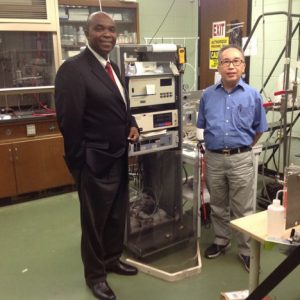
Chemical engineering professor Wei-Yin Chen (right) and Nosa Egiebor are the principle and co-principle investigators for the UM portion of a collaborative NSF EPSCoR Track II grant. (Submitted photo)
Two heads are better than one, especially when a multimillion-dollar research grant is involved.
University of Mississippi chemical engineering professors Wei-Yin Chen and Nosa Egiebor are the co-principal investigators of the UM Sustainable Energy and Environment research group. SEE has been awarded $1.6 million of the National Science Foundation’s EPSCoR Track II grant for “Collaborative Research and Education on Synergized Transformational Solar Chemical Looping and Photo-Ultrasonic Renewable Biomass Refinery.”
The $6 million award for the four-year research project is shared by a consortium of four universities. Jackson State University is the lead institution. Others include UM, the University of Delaware and the University of Wyoming. The grant period began Aug. 1 and runs through July 31, 2020.
“The project is aimed at developing a sequential set of novel technologies in the biomass utilization and refinery research that contribute directly to the energy, environment, food and water nexus,” Chen said.
“The creation of a successful consortium requires expertise in different academic fields. Indeed, the investigators of these four universities have produced renowned original works in their own fields that are also related to those of other members of the consortium.”
The project seeks novel and cost-effective approaches to mitigate climate change, improve energy efficiency and reduce pollutants in water and air, which are among the most significant challenges facing the world. The NSF award is extremely timely, particularly because SEE’s research goal is based on a completely new approach that is ready for the next level of research investigation.
“We are truly grateful to NSF for this award,” Egiebor said.
Other UM team members include Daniell Mattern, Nathan Hammer and Davita Watkins of the Department of Chemistry and Biochemistry, Charles Church of the National Center for Physical Acoustics and Joel Mobley of the Department of Physics and Astronomy.
“The original concepts of utilizing photochemical and ultrasonic treatments of biochar for various technologies were developed by UM’s chemical engineers,” Chen said. “The scientists at the National Center for Physical Acoustics and in the Department of Physics and Astronomy have been optimizing the proposed processes. The UM chemists have been elucidating the reaction mechanisms.”